Investigation on the Mechanism of Heat Load Reduction for the Thermal Anti-Icing System
Abstract
1. Introduction
2. Numerical Simulation and Optimization Method
2.1. Modeling of the Anti-Icing Process
2.2. Optimization Method of the Anti-Icing Heat Load
3. Experimental Setup and Test Model
4. Results and Discussions
4.1. Validation of the Numerical Simulation
4.1.1. Convective Heat Transfer Coefficient
4.1.2. Water Droplet Impinging Limit
4.1.3. Surface Temperature
4.2. The Optimal Heating Power Distribution
4.3. Mechanism of the Anti-Icing Heat Load Reduction
4.3.1. Heating Range
4.3.2. Surface Temperature
4.3.3. Convective Heat Transfer Coefficient
5. Conclusions
- (1)
- The reduction in the anti-icing heat load is the decrease in the convective heat load. As the thermal anti-icing system operating in the evaporative mode, the evaporative heat load keeps nearly constant. The convective heat load can be varied with the surface temperature distribution which is influenced by the heating power distribution. Thus, there must be an optimal heating power distribution that can reduce the convective heat load as well as the anti-icing heat load.
- (2)
- The optimal heating power density obtained by the numerical optimization and the experiment has such characteristics that are low at the leading edge, high at the water droplet impinging limit and zero at the end of the protected area. These characteristics are mainly influenced by the heating range, the surface temperature and the convective heat transfer coefficient. In the evaporative mode, decreasing the heating range outside the protected area can reduce the anti-icing heat load effectively. As the heating range is decreased to the impinging limit, the anti-icing heat load has the minimum value. Due to the different impacts of the surface temperature on the evaporative and convective heat fluxes, it is better to evaporate the runback water in the high-temperature region, which can lead to a lesser additional convective heat load. The surface temperature distribution is affected by the convective heat transfer coefficient distribution of which the trend is high at the leading edge and decreases chordwise around the airfoil surface. As a consequence, the optimal heating power distribution has the opposite trend with the convective heat transfer coefficient distribution.
Author Contributions
Funding
Acknowledgments
Conflicts of Interest
References
- Green, S. A Study of U.S. Inflight Icing Accidents and Incidents, 1978 to 2002. In Proceedings of the 44th AIAA Aerospace Sciences Meeting and Exhibit, Reno, NV, USA,, 9–12 January 2006. AIAA-2006-82. [Google Scholar]
- Thomas, S.K.; Cassoni, R.P.; MacArthur, C.D. Aircraft anti-icing and de-icing techniques and modeling. J. Aircr. 1996, 33, 841–854. [Google Scholar] [CrossRef]
- Cronin, M. The prospects and potential of all electric aircraft. Aircraft Design. In Proceedings of the Systems and Technology Meeting, Fort Worth, TX, USA, 17–19 October 1983. AIAA-83-2478. [Google Scholar]
- Ingram, C.; Dendinger, T.; Inclan, E.; Charront, Y.; Handschuh, K.; Chakraborty, I.; García, E.; Mavris, D.N. Integrating Subsystem Sizing into the More Electric Aircraft Conceptual Design Phase. In Proceedings of the 53rd AIAA Aerospace Sciences Meeting, Kissimmee, FL, USA, 5–9 January 2015. AIAA-2015-1682. [Google Scholar]
- Chakraborty, I.; Ozcan, M.F.; Mavris, D.N. Effect of Major Subsystem Power Off-takes on Aircraft Performance in More Electric Aircraft Architectures. In Proceedings of the 15th AIAA Aviation Technology, Integration, and Operations Conference, Dallas, TX, USA, 22–26 January 2015. AIAA-2015-3287. [Google Scholar]
- Gandolfi, R.; Pellegrini, L.; De Oliveira, S. More Electric Aircraft Analysis Using Exergy as a Design Comparison Tool. In Proceedings of the 48th AIAA Aerospace Sciences Meeting Including the New Horizons Forum and Aerospace Exposition, Orlando, FL, USA, 4–7 January 2010. AIAA 2010-809. [Google Scholar]
- Ensign, T.; Gallman, J. Energy Optimized Equipment Systems for General Aviation Jets. In Proceedings of the 44th Aerospace Sciences Meeting and Exhibit, Reno, NV, USA, 9–12 January 2006. AIAA 2006-228. [Google Scholar]
- Wang, P.; Wei, W.; Li, Z.; Duan, W.; Han, H.; Xie, Q. A superhydrophobic fluorinated PDMS composite as a wearable strain sensor with excellent mechanical robustness and liquid impalement resistance. J. Mater. Chem. A 2020, 8, 3509–3516. [Google Scholar] [CrossRef]
- He, Z.; Zhuo, Y.; Wang, F.; He, J.; Zhang, Z. Design and preparation of icephobic PDMS-based coatings by introducing an aqueous lubricating layer and macro-crack initiators at the ice-substrate interface. Prog. Org. Coat. 2020, 147, 105737. [Google Scholar] [CrossRef]
- Brassard, J.-D.; Laforte, J.-L.; Blackburn, C.; Perron, J.; Sarkar, D.K. Silicone based superhydrophobic coating efficient to reduce ice adhesion and accumulation on aluminum under offshore arctic conditions. Ocean. Eng. 2017, 144, 135–141. [Google Scholar] [CrossRef]
- Ma, L.; Wang, J.; Zhao, F.; Wu, D.; Huang, Y.; Zhang, D.; Zhang, Z.; Fu, W.; Li, X.; Fan, Y. Plasmon-mediated photothermal and superhydrophobic TiN-PTFE film for anti-icing/de-icing applications. Compos. Sci. Technol. 2019, 181, 107696. [Google Scholar] [CrossRef]
- Lv, J.; Zhu, C.; Qiu, H.; Zhang, J.; Gu, C.; Feng, J. Robust icephobic epoxy coating using maleic anhydride as a crosslinking agent. Prog. Org. Coat. 2020, 142, 105561. [Google Scholar] [CrossRef]
- Wang, P.; Yao, T.; Li, Z.; Wei, W.; Xie, Q.; Duan, W.; Han, H. A superhydrophobic/electrothermal synergistically anti-icing strategy based on graphene composite. Compos. Sci. Technol. 2020, 198, 108307. [Google Scholar] [CrossRef]
- Silva, G.; Silvares, O.; Zerbini, E.; Hefazi, H.; Chen, H.-H.; Kaups, K. Differential Boundary-Layer Analysis and Runback Water Flow Model Applied to Flow Around Airfoils with Thermal Anti-ice. In Proceedings of the 1st AIAA Atmospheric and Space Environments Conference, San Antonio, TX, USA, 22–25 June 2009. AIAA 2009-3967. [Google Scholar]
- Broeren, A.P.; Whalen, E.A.; Busch, G.T.; Bragg, M.B. Aerodynamic Simulation of Runback Ice Accretion. J. Aircr. 2010, 47, 924–939. [Google Scholar] [CrossRef]
- Whalen, E.; Broeren, A.; Bragg, M.; Lee, S. Characteristics of Runback Ice Accretions on Airfoils and their Aerodynamics Effects. In Proceedings of the 43rd Aerospace Sciences Meeting and Exhibit, Reno, NV, USA, 10–13 January 2005. AIAA-2005-1065. [Google Scholar]
- Alègre, N.; Hammond, D. Experimental Setup for the Study of Runback Ice at Full Scale. J. Aircr. 2011, 48, 1978–1983. [Google Scholar] [CrossRef]
- Wright, W.B. User’s Manual for the Improved NASA Lewis Ice Accretion Code LEWICE 1.6; CR-198355; NASA: Washington, DC, USA, 1995.
- Wright, W.B. User’s Manual for the NASA Glenn Ice Accretion Code LEWICE Version 2.0; CR-209409; NASA: Washington, DC, USA, 1999.
- Morency, F.; Brahimi, T.; Tezok, F.; Paraschivoiu, I. Hot air anti-icing system modelization in the ice prediction code CANICE. In Proceedings of the 36th AIAA Aerospace Sciences Meeting and Exhibit, Reno, NV, USA, 12–15 January 1998. AIAA Paper 1998-0192. [Google Scholar]
- Morency, F.; Tezok, F.; Paraschivoiu, I.; Para, F.; Morency, O. Anti-Icing System Simulation Using CANICE. J. Aircr. 1999, 36, 999–1006. [Google Scholar] [CrossRef]
- Baruzzi, G.; Tran, P.; Habashi, W.; Narramore, J. Actuator Disk Implementation in FENSAP-ICE, a 3D Navier-Stokes In-Flight Simulation System. In Proceedings of the 41st Aerospace Sciences Meeting and Exhibit, Reno, NV, USA, 6–9 January 2003. AIAA-2003-0619. [Google Scholar]
- Morency, F.; Beaugendre, H.; Habashi, W.G. FENSAP-ICE: A study of the effect of ice shapes on droplet impingement. In Proceedings of the 41st Aerospace Sciences Meeting and Exhibit, Reno, NV, USA, 6–9 January 2003. AIAA-2003-1223. [Google Scholar]
- Al-Khalil, K.M.; Horvath, C.; Miller, D.R.; Wright, W. Validation of NASA Thermal Ice Protection Computer Codes. Ⅲ –Validation of ANTICE. In Proceedings of the 35th Aerospace Sciences Meeting and Exhibit, Reno, NV, USA, 6–9 January 1997. AIAA 1997-51. [Google Scholar]
- Saeed, F.; Paraschivoiu, I. Optimization of a Hot-Air Anti-Icing System. In Proceedings of the 41st Aerospace Sciences Meeting and Exhibit, Reno, NV, USA, 6–9 January 2003. AIAA-2003-0733. [Google Scholar]
- Pellissier, M.P.C.; Habashi, W.G.; Pueyo, A. Optimization via FENSAP-ICE of Aircraft Hot-Air Anti-Icing Systems. J. Aircr. 2011, 48, 265–276. [Google Scholar] [CrossRef]
- Chen, L.; Zhang, Y.; Wu, Q. Heat transfer optimization and experimental validation of anti-icing component for helicopter rotor. Appl. Eng. 2017, 127, 662–670. [Google Scholar] [CrossRef]
- Pourbagian, M.; Habashi, W.G. Surrogate-Based Optimization of Electrothermal Wing Anti-Icing Systems. J. Aircr. 2013, 50, 1555–1563. [Google Scholar] [CrossRef]
- Pourbagian, M.; Habashi, W. On Optimal Design of Electro-Thermal In-Flight Ice Protection Systems. In Proceedings of the 5th AIAA Atmospheric and Space Environments Conference, San Diego, CA, USA, 24–27 June 2013. AIAA 2013-2937. [Google Scholar]
- Pourbagian, M.; Talgorn, B.; Habashi, W.G.; Kokkolaras, M.; Le Digabel, S. Constrained problem formulations for power optimization of aircraft electro-thermal anti-icing systems. Optim. Eng. 2015, 16, 663–693. [Google Scholar] [CrossRef]
- Chang, S.; Zhao, Y.; Yang, B.; Leng, M.; Wang, C. Study on the Minimum Anti-Icing Energy Based on the Icing Limit State. J. Aircr. 2016, 53, 1690–1696. [Google Scholar] [CrossRef]
- Messinger, B.L. Equilibrium Temperature of an Unheated Icing Surface as a Function of Air Speed. J. Aeronaut. Sci. 1953, 20, 29–42. [Google Scholar] [CrossRef]
- Chen, W. Numerical Simulation of Ice Accretion on Airfoil. Ph.D. Thesis, Nanjing University of Aeronautics and Astronautics, Nanjing, China, 2007. [Google Scholar]
- Villalpando, F.; Reggio, M.; Ilinca, A. Prediction of ice accretion and anti-icing heating power on wind turbine blades using standard commercial software. Energy 2016, 114, 1041–1052. [Google Scholar] [CrossRef]
- Al-Khalil, K.M. Numerical Simulation of an Aircraft Anti-icing System Incorporating a Rivulet Model for the Runback Water. Ph.D. Thesis, The University of Toledo, Toledo, OH, USA, 1991. [Google Scholar]
- Elangovan, R.; Olsen, R. Analysis of Layered Composite Skin Electro-Thermal Anti-Icing System. In Proceedings of the 46th AIAA Aerospace Sciences Meeting and Exhibit, Reno, NV, USA, 7–10 January 2008. AIAA 2008-446. [Google Scholar]
- Mivehchi, H.; Varvani-Farahani, A. The effect of temperature on fatigue strength and cumulative fatigure damage of FRP composites. Procedia Eng. 2010, 2, 2011–2020. [Google Scholar] [CrossRef]
- National Research Council. Accelerated Aging of Materials and Structures; The National Academies Press: Washington, DC, USA, 1996; pp. 24–25.
- Goldberg, D.E. Genetic Algorithms in Search, Optimization, and Machine Learning; Addison-Wesley Professional: Longman, MA, USA, 1989; pp. 55–60. [Google Scholar]
- Meng, F. Study on Key Problems in Airfoil Icing Simulation. Ph.D. Thesis, Nanjing University of Aeronautics and Astronautics, Nanjing, China, 2013. [Google Scholar]
- Poinsatte, P.E.; Newton, J.E.; De Witt, K.J.; Van Fossen, G.J. Heat transfer measurements from a smooth NACA 0012 airfoil. J. Aircr. 1991, 28, 892–898. [Google Scholar] [CrossRef]
- Abdel-Wahab, A.; Ataya, S.; Silberschmidt, V.V. Temperature-dependent mechanical behaviour of PMMA: Experimental analysis and modelling. Polym. Test. 2017, 58, 86–95. [Google Scholar] [CrossRef]
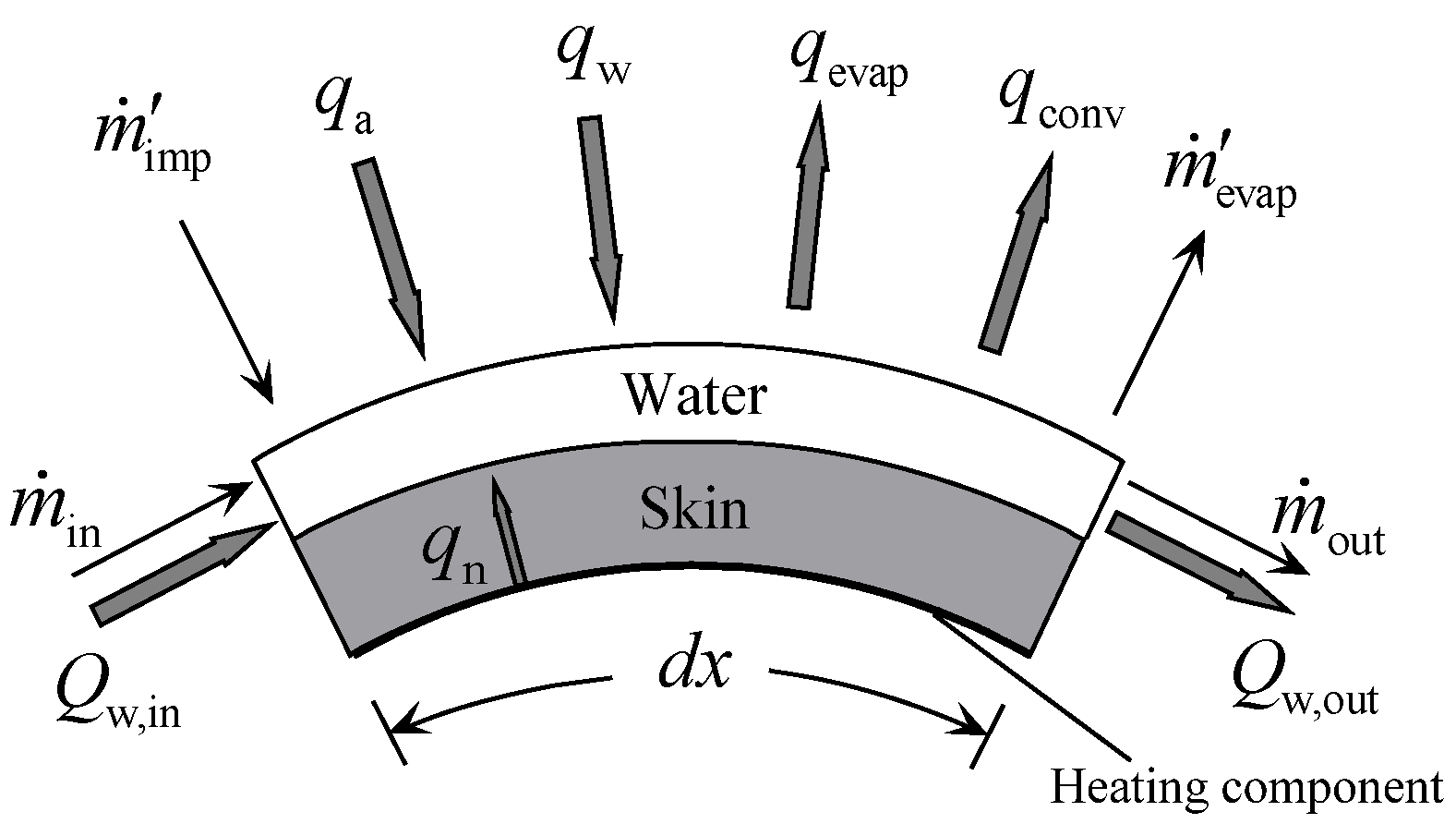
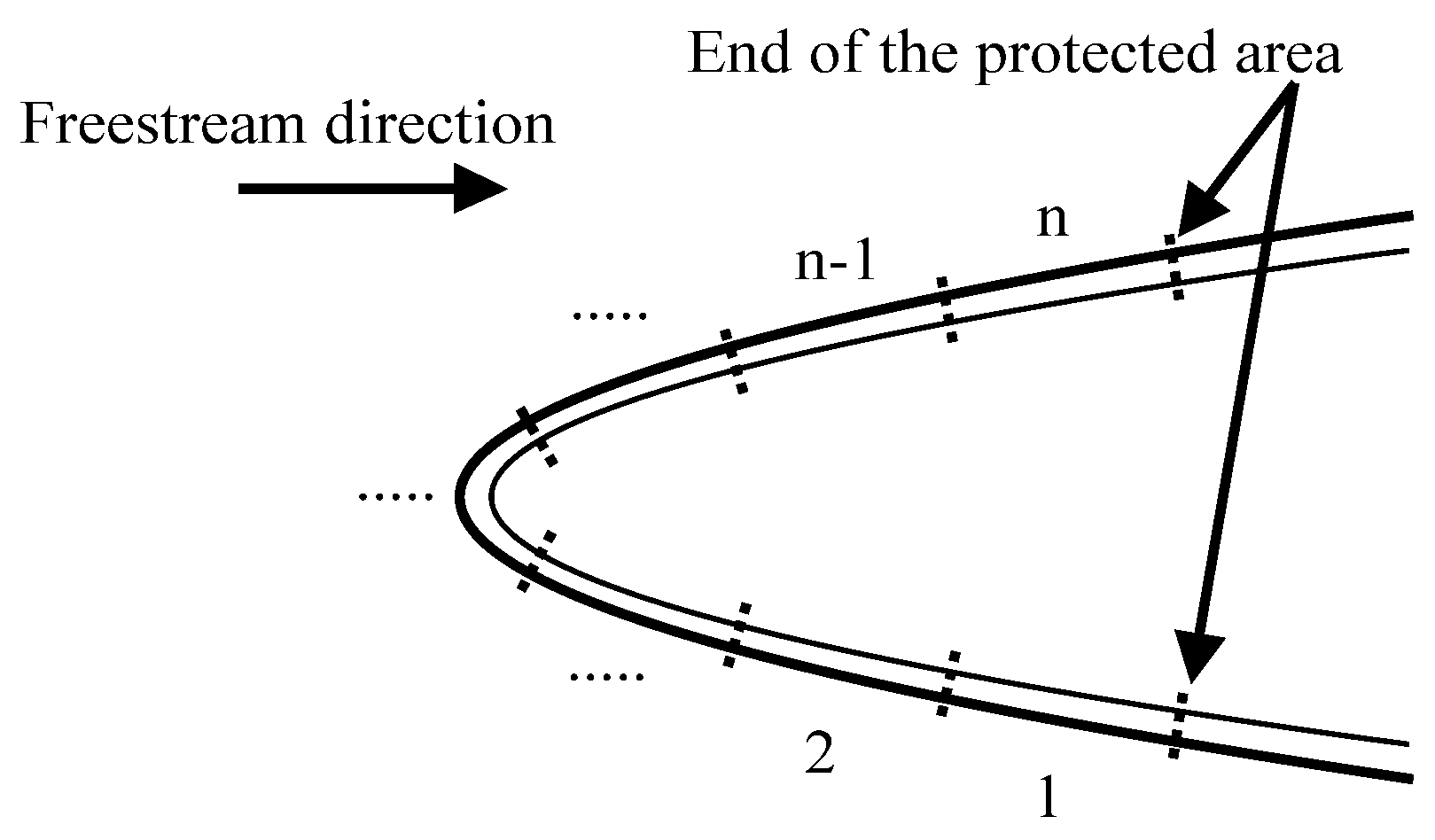


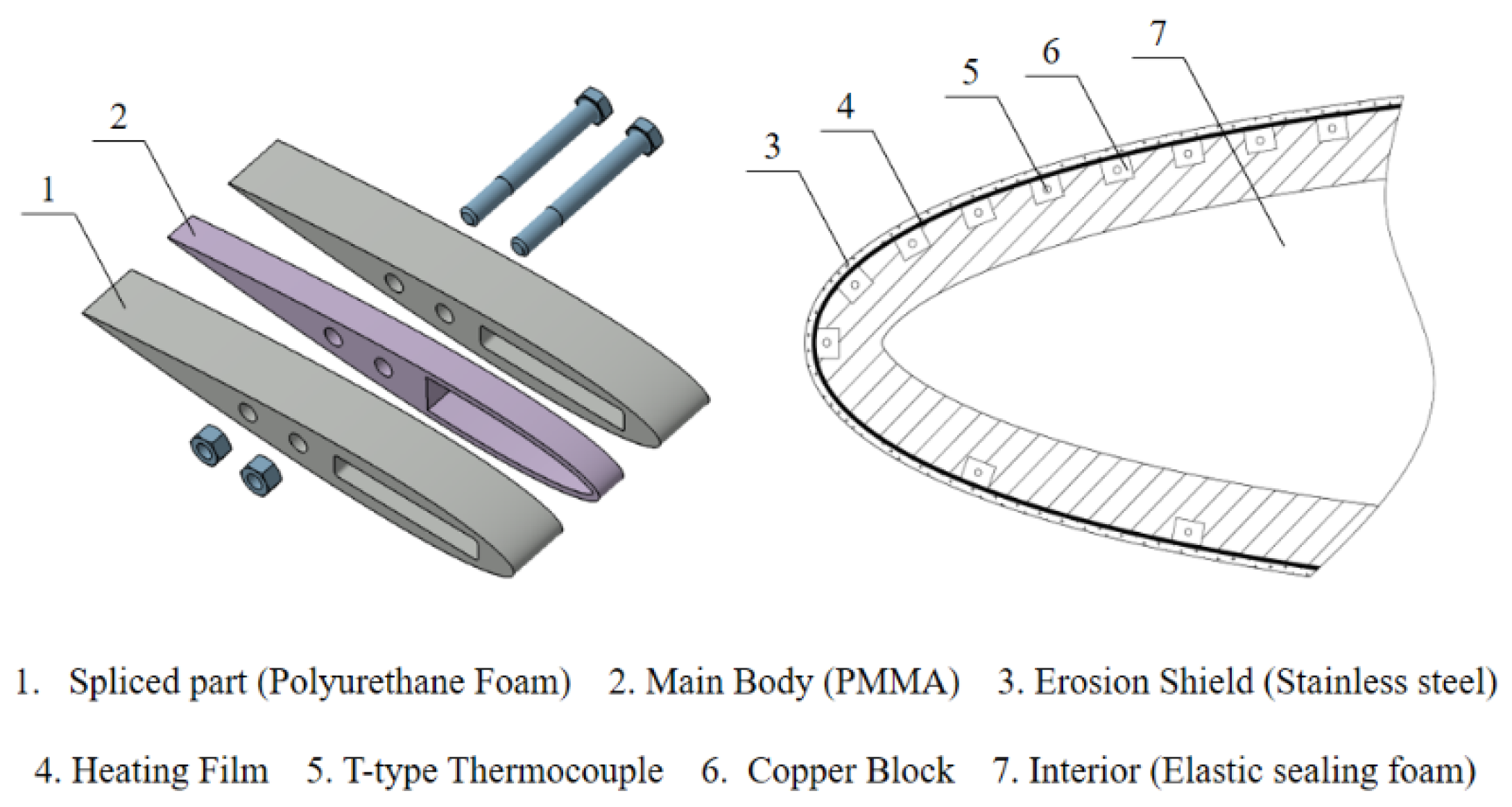
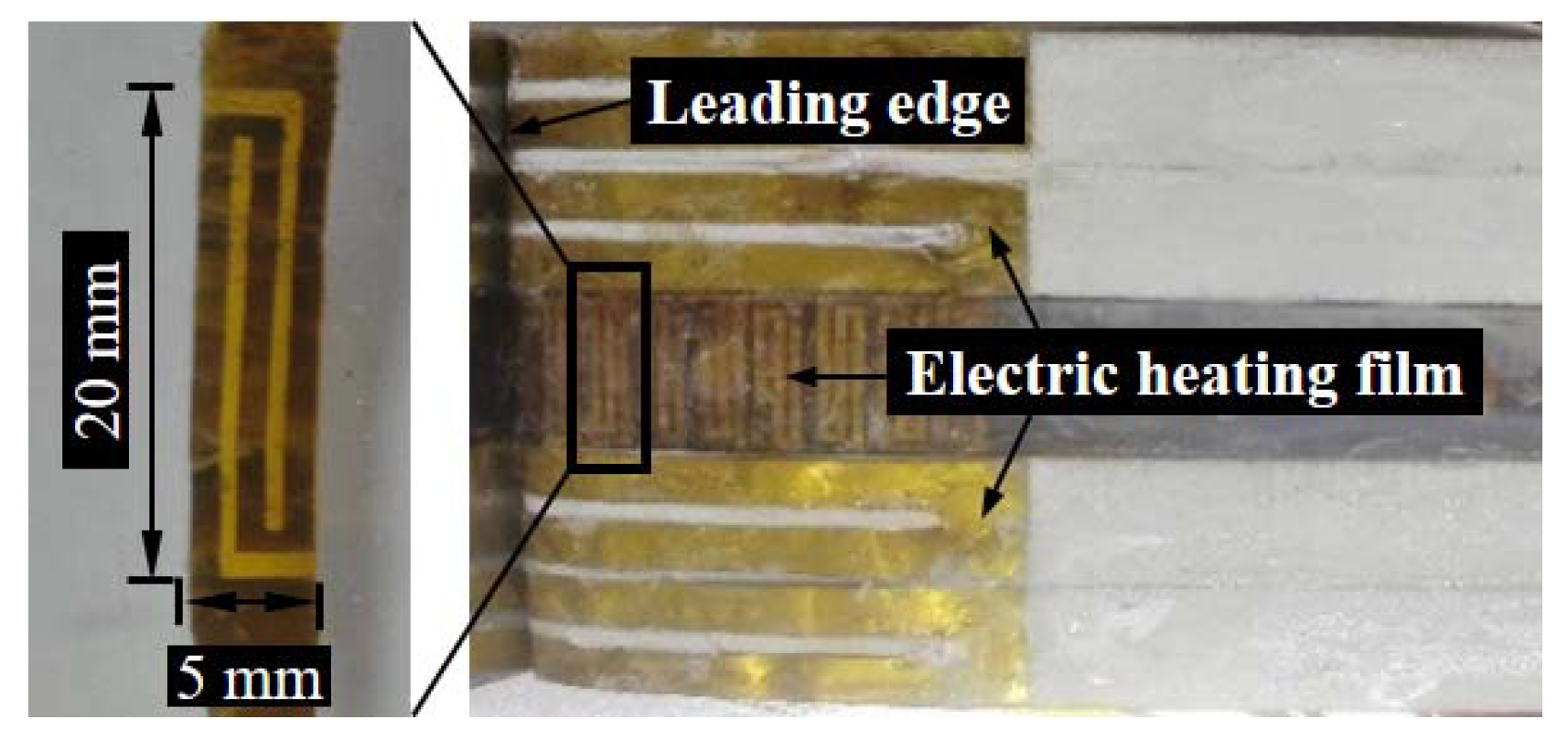
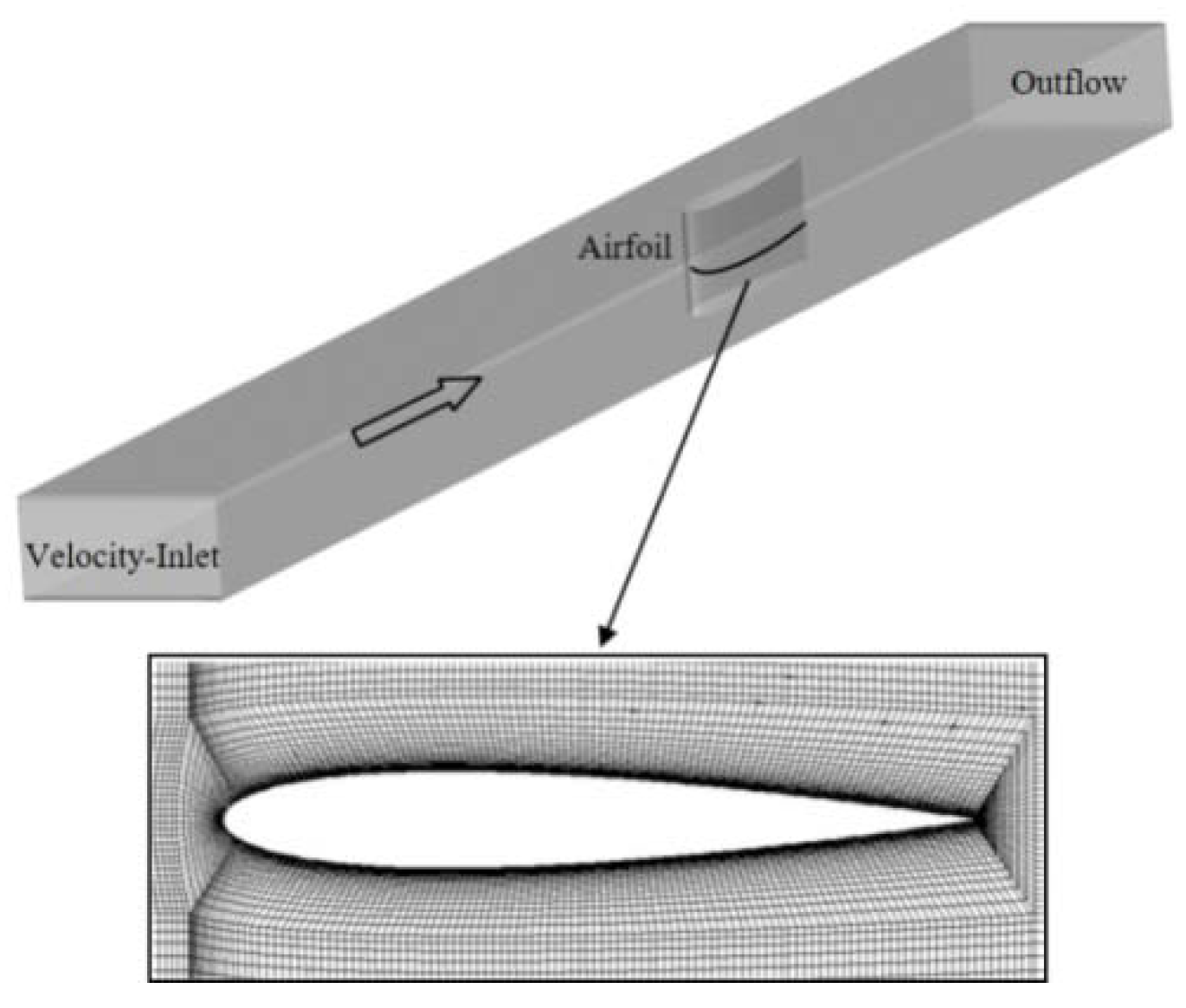
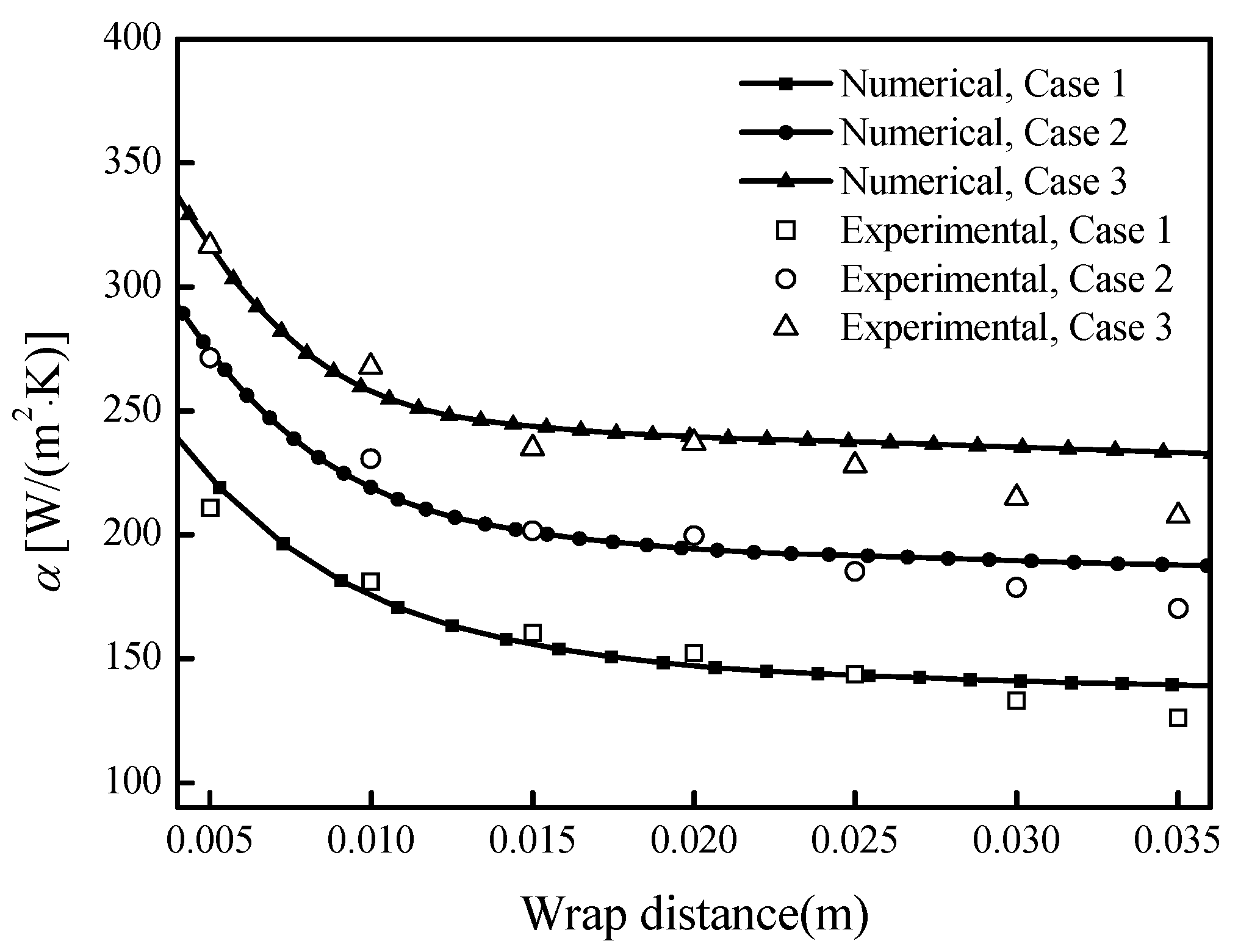
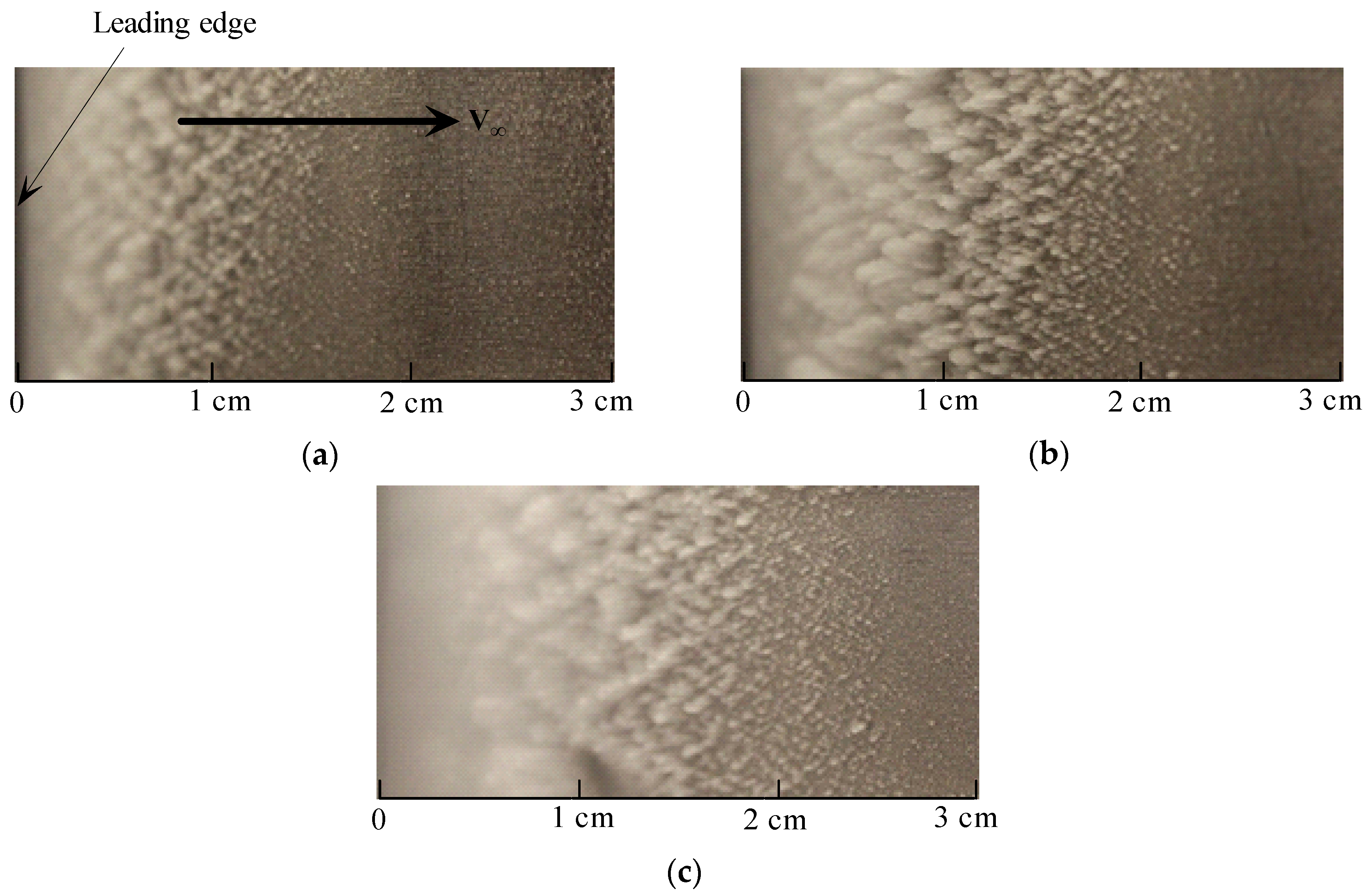
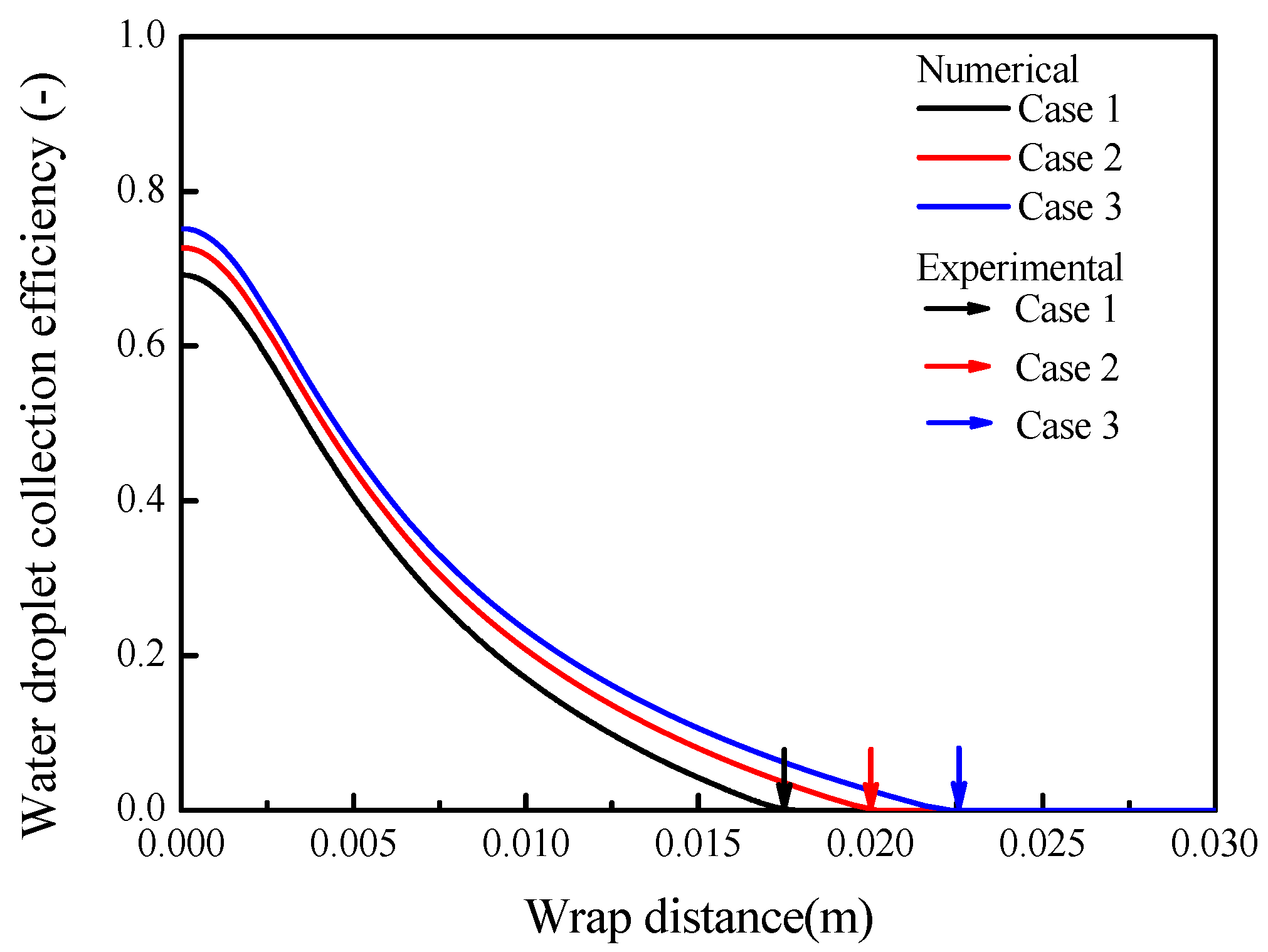
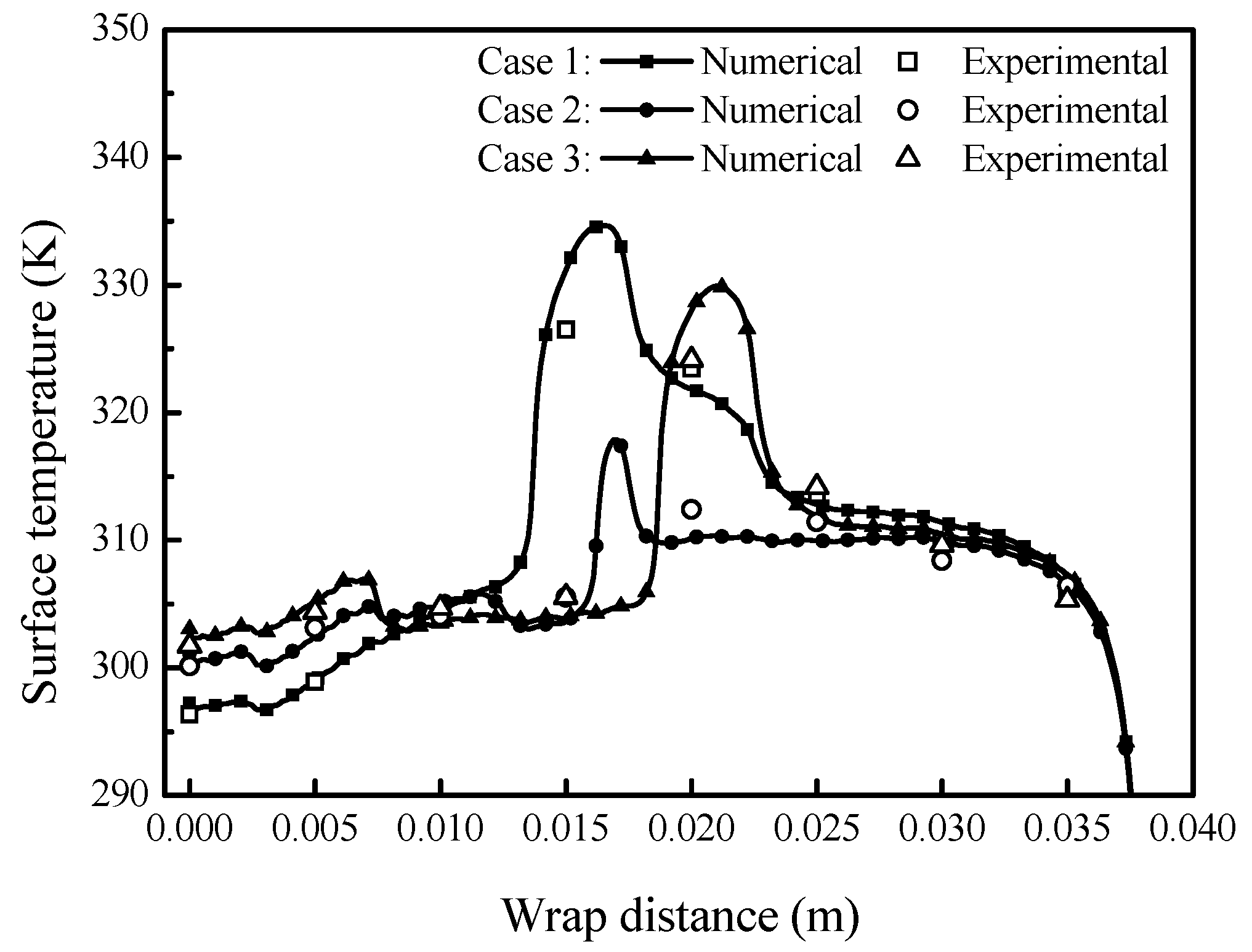

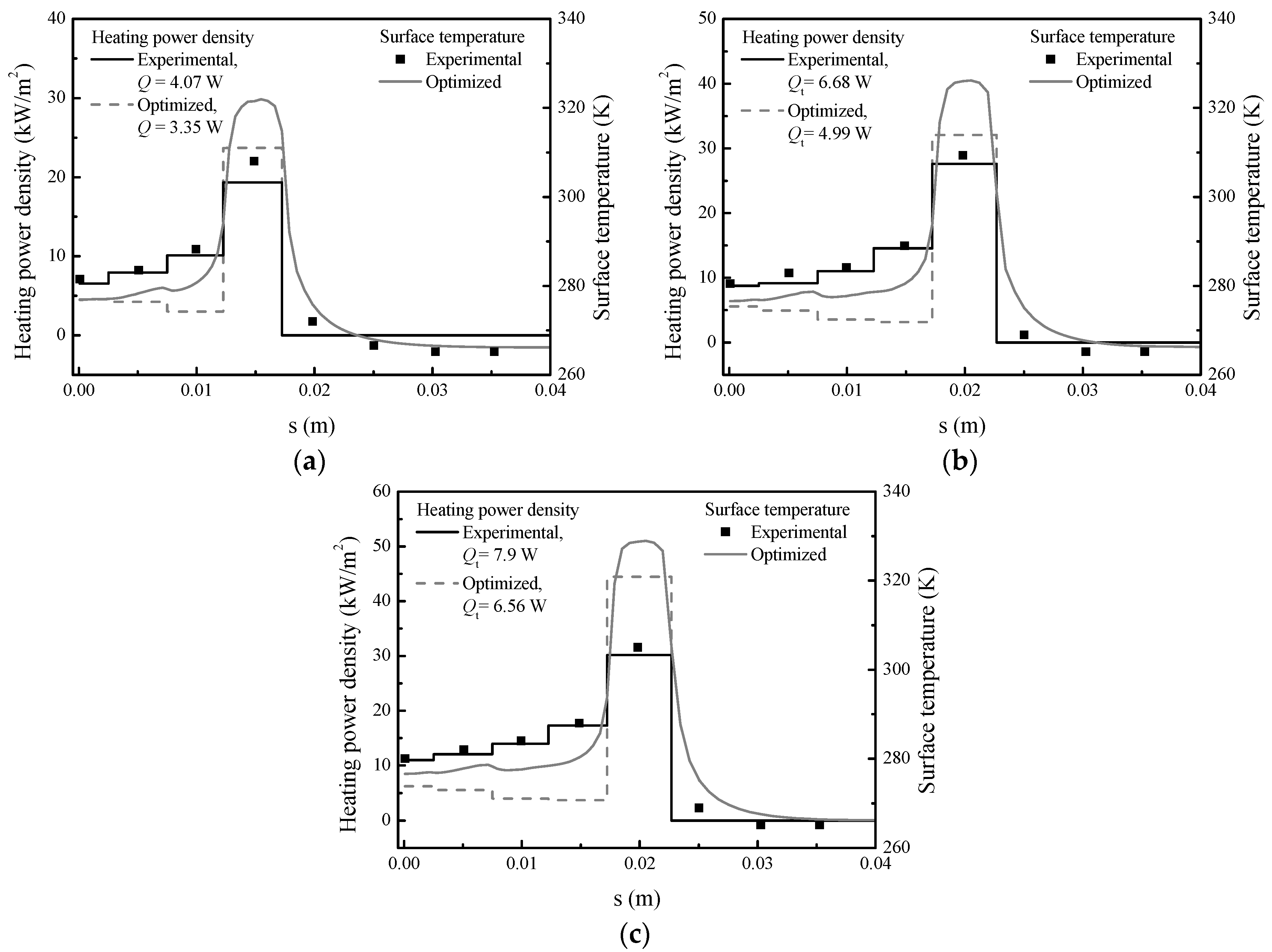
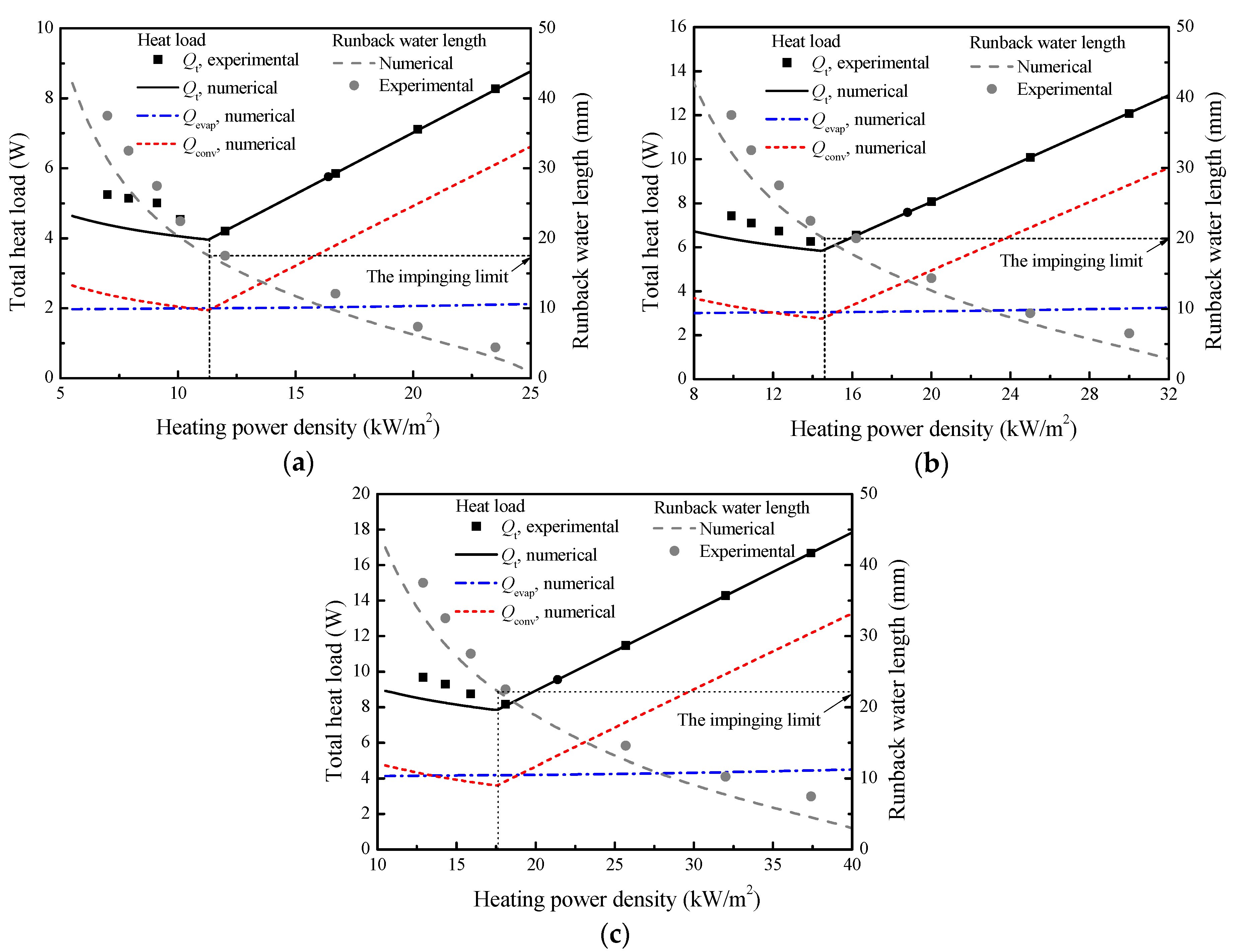


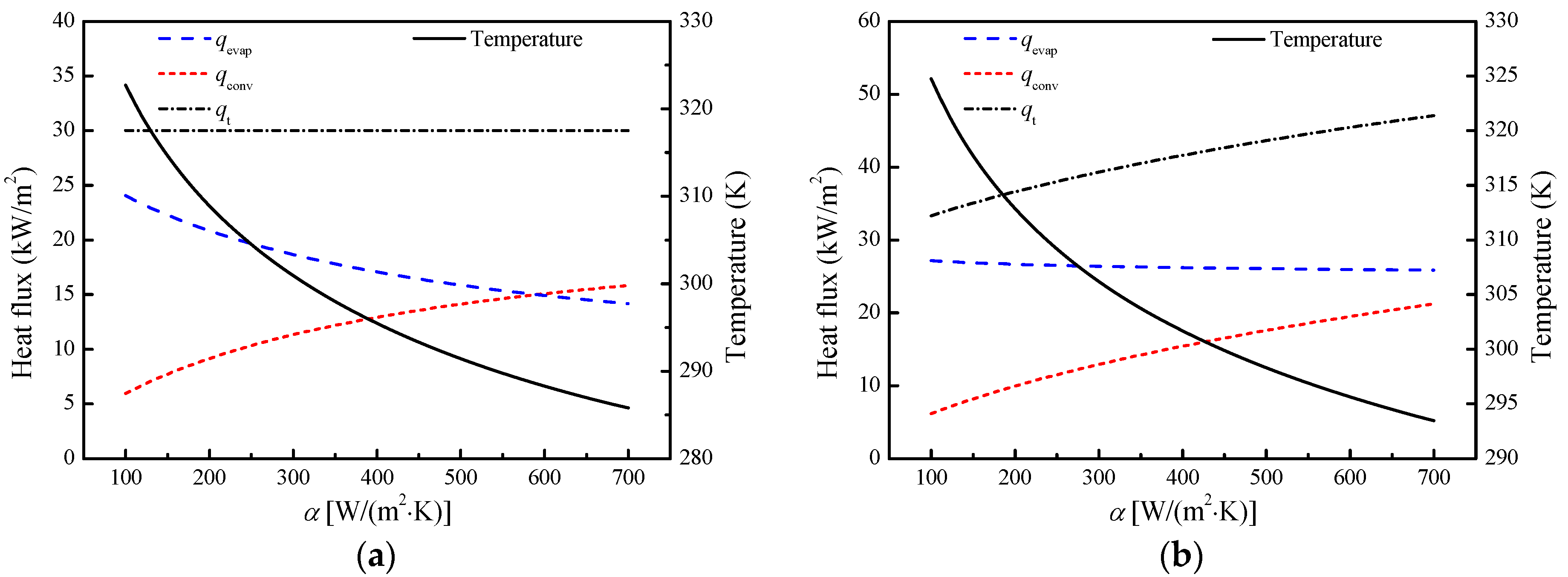
| Heating Zones | Start (mm) | End (mm) | Heating Area (mm2) |
|---|---|---|---|
| 1 | 0 | 2.5 | 50 |
| 2 | 2.5 | 7.5 | 100 |
| 3 | 7.5 | 12.5 | 100 |
| 4 | 12.5 | 17.5 | 100 |
| 5 | 17.5 | 22.5 | 100 |
| 6 | 22.5 | 27.5 | 100 |
| 7 | 27.5 | 32.5 | 100 |
| 8 | 32.5 | 37.5 | 100 |
| Material | Density, kg/m3 | Specific Heat, kJ/(kg·K) | Conductivity, W/(m·K) | Thickness, mm |
|---|---|---|---|---|
| Stainless Steel | 7930 | 0.5 | 16.3 | 0.10 |
| Polyimide | 1400 | 1.1 | 0.2 | 0.06 |
| Nickel-Chromium Alloys | 8400 | 0.46 | 12.2 | 0.03 |
| PMMA(Poly Methyl Methacrylatemethacrylic Acid) | 1190 | 1.47 | 0.19 | 4.00 |
| Polyurethane Foam | 3500 | 2.48 | 0.024 | - |
| Case | u∞, m/s | T∞, K | LWC, g/m3 | MVD, μm |
|---|---|---|---|---|
| 1 | 30 | 263.15 | 0.27 | 20 |
| 2 | 40 | 263.15 | 0.27 | 20 |
| 3 | 50 | 263.15 | 0.27 | 20 |
| Case | Heating Film Power Density (kW/m2) | |||||||
|---|---|---|---|---|---|---|---|---|
| 1 | 2 | 3 | 4 | 5 | 6 | 7 | 8 | |
| 1 | 19.9 | 17.2 | 15.4 | 14.9 | 13.1 | 7.2 | 7.3 | 7.2 |
| 2 | 24.8 | 21.0 | 18.4 | 15.1 | 9.0 | 8.8 | 9.0 | 8.9 |
| 3 | 30.3 | 27.1 | 19.6 | 18.6 | 17.9 | 10.7 | 10.9 | 10.8 |
Publisher’s Note: MDPI stays neutral with regard to jurisdictional claims in published maps and institutional affiliations. |
© 2020 by the authors. Licensee MDPI, Basel, Switzerland. This article is an open access article distributed under the terms and conditions of the Creative Commons Attribution (CC BY) license (http://creativecommons.org/licenses/by/4.0/).
Share and Cite
Li, R.; Zhu, G.; Zhang, D. Investigation on the Mechanism of Heat Load Reduction for the Thermal Anti-Icing System. Energies 2020, 13, 5911. https://doi.org/10.3390/en13225911
Li R, Zhu G, Zhang D. Investigation on the Mechanism of Heat Load Reduction for the Thermal Anti-Icing System. Energies. 2020; 13(22):5911. https://doi.org/10.3390/en13225911
Chicago/Turabian StyleLi, Rongjia, Guangya Zhu, and Dalin Zhang. 2020. "Investigation on the Mechanism of Heat Load Reduction for the Thermal Anti-Icing System" Energies 13, no. 22: 5911. https://doi.org/10.3390/en13225911
APA StyleLi, R., Zhu, G., & Zhang, D. (2020). Investigation on the Mechanism of Heat Load Reduction for the Thermal Anti-Icing System. Energies, 13(22), 5911. https://doi.org/10.3390/en13225911






